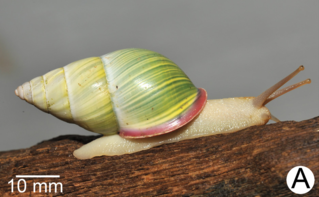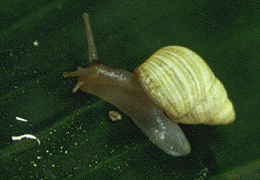
Powelliphanta is a genus of large, air-breathing land snails, pulmonate gastropods in the family Rhytididae, found only in New Zealand. They are carnivorous, eating invertebrates, mostly native earthworms. Often restricted to very small areas of moist forest, they are prey to introduced mammalian predators, and many species are threatened or endangered.

Euchondrus is a genus of very small air-breathing land snails, terrestrial pulmonate gastropod mollusks in the family Enidae.

Bermuda land snails, scientific name Poecilozonites, are an endemic genus of pulmonate land snail in the family Gastrodontidae. 12 species are known from the fossil record, and 4 of these species survived into modern times, but due to the highly negative effects of human development, the extant species has been reduced down to only bermudensis and circumfirmatus.

Helicinidae is a family of small tropical land snails which have an operculum. They are terrestrial operculate gastropod mollusks in the superfamily Helicinoidea.

Aaadonta is a genus of air-breathing land snails, terrestrial pulmonate gastropod mollusks in the family Endodontidae. Specimens from this genus are endemic to Palau.

Amphidromus is a genus of tropical air-breathing land snails, terrestrial pulmonate gastropod mollusks in the family Camaenidae. The shells of Amphidromus are relatively large, from 25 mm (0.98 in) to 75 mm (3.0 in) in maximum dimension, and particularly colorful. During the 18th century, they were among the first Indonesian land snail shells brought to Europe by travelers and explorers. Since then, the genus has been extensively studied: several comprehensive monographs and catalogs were authored by naturalists and zoologists during the time period from the early 19th to the mid 20th centuries. Modern studies have focused on better understanding the evolutionary relationships within the group, as well as solving taxonomic problems.

Georissa is a genus of minute land snails, terrestrial gastropod mollusks in the family Hydrocenidae. Although the species are best known for living on the surface of limestone rocks, they are often also found in and on the vegetation and on non-calcareous rocks. One species, Georissa filiasaulae, is cavernicolous. It is only known from two caves in the Sepulut area of Sabah, Malaysian Borneo, where its above-ground sister species, Georissa saulae, inhabits the rocks outside of the cave, and is connected to the cave snail via narrow zones of hybridization at the cave entrances. Possibly, G. filiasaulae has evolved without ever having been fully separated from its ancestor, a process known as speciation-with-gene-flow.
Hacrochlamys lineolatus is a species of small air-breathing land snails, terrestrial pulmonate gastropod mollusks in the family Euconulidae, the hive snails.
Hungerfordia is a genus of small land snails with an operculum, a terrestrial gastropod mollusk in the family Diplommatinidae endemic to the Republic of Palau. Many of the members of this genus inhabit limestone cliffs or rubble, especially in the Rock Islands (Chelbacheb) in Airai, Koror, and Peleliu states. As of 2022, there are 41 described species in this genus. A series of revisions in 2013 - 2015 described several new species, as well as transferring Palauan members of the genus Diplommatina or Palaina into Hungerfordia.

A land snail is any of the numerous species of snail that live on land, as opposed to the sea snails and freshwater snails. Land snail is the common name for terrestrial gastropod mollusks that have shells. However, it is not always easy to say which species are terrestrial, because some are more or less amphibious between land and fresh water, and others are relatively amphibious between land and salt water.

Achatinellidae is a family of tropical air-breathing land snails, terrestrial pulmonate gastropod mollusks in the superfamily Pupilloidea.

Camaenidae is a family of air-breathing land snails, terrestrial pulmonate gastropod mollusks in the superfamily Helicoidea, the typical snails and their allies. This is one of the most diverse families in the clade Stylommatophora.

Abida is a genus of small air-breathing land snails, terrestrial gastropod mollusks in the family Chondrinidae.

Liguus is a genus of large tropical air-breathing land snails, more specifically arboreal or tree snails, terrestrial pulmonate gastropod mollusks in the family Orthalicidae.

Partula is a genus of air-breathing tropical land snails, terrestrial pulmonate gastropod mollusks in the family Partulidae.
Albinaria is a genus of air-breathing land snails, terrestrial pulmonate gastropod mollusks in the family Clausiliidae, the door snails.

Alecton discoidalis is a species of firefly in the beetle family Lampyridae, commonly known as the Cuban endemic firefly. The larvae of this species are predators on both pulmonate and operculate land snails. Alecton discoidalis is the type species of the genus Alecton.

Abbottella is a genus of operculate land snails, terrestrial gastropod mollusks gastropod in the family Pomatiidae.

Pollicaria, commonly known as the elephant pupinid snails, is a genus of land snails with a gill and an operculum. They are in the family Pupinidae, superfamily Cyclophoroidea.















